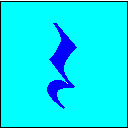 A rest means no sound is to be played for a
duration of time. The various types of rest symbols, like the various types of note
shapes, signify different durations of silence in time.
A rest means no sound is to be played for a
duration of time. The various types of rest symbols, like the various types of note
shapes, signify different durations of silence in time.
![]()
A rest indicates a duration of silence. Various rest symbols signify different durations of silence. rests may apply to one or several voices depending whether or not there is linear independence in the music.
 Independent voices, placed
on the same musical staff, will require their own rests. As one voice has a moment of silence, the others continue to sound.
Independent voices, placed
on the same musical staff, will require their own rests. As one voice has a moment of silence, the others continue to sound.
 Harmonic progressions do not require a rest for each
note in a chord. One rest is sufficient between chords. In most cases the rest will apply
to melody for one staff and harmony for the other.
Harmonic progressions do not require a rest for each
note in a chord. One rest is sufficient between chords. In most cases the rest will apply
to melody for one staff and harmony for the other.
Rests are placed within a measure as such that the beats and its divisions are clearly defined.
 A measure, divisible by
two, can be divided into two equal parts. A rest must not overlap between two equally
divided parts. Overlapped rests will have the divisions in the measure
appear uneven. This also applies to the subdivisions of the beat.
A measure, divisible by
two, can be divided into two equal parts. A rest must not overlap between two equally
divided parts. Overlapped rests will have the divisions in the measure
appear uneven. This also applies to the subdivisions of the beat.
 In triple time, a measure can not be divided into two equal parts. The choice of
rests is optional. Assuming that the divisions of the beat are in equal parts, appropriate
rests must be used as stated above.
In triple time, a measure can not be divided into two equal parts. The choice of
rests is optional. Assuming that the divisions of the beat are in equal parts, appropriate
rests must be used as stated above.
 A whole rest is usually equivalent, in value, to the
whole note. It is often placed in an empty measure regardless
of the time value as indicated by the time signature.
A whole rest is usually equivalent, in value, to the
whole note. It is often placed in an empty measure regardless
of the time value as indicated by the time signature.